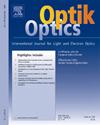Tailoring the morphological, optical, electrical, and random lasing properties of ZnO nanorods synthesized on metal surfaces for biosensor applications
IF 3.1
3区 物理与天体物理
Q2 Engineering
引用次数: 0
Abstract
Laser-based sensors are taking over their counterparts, fluorescence-based sensors, in the field of bioengineering and space communication due to their high amplification, narrow emission beam, low signal-to-noise ratio, and nonlinearity. In this work, we investigated the chemical growth of ZnO nanorods on different metal surfaces (Au, Pt, Ti, and Al) to serve as random laser mediums. Different analytical techniques were used to investigate the optical, electrical, and morphological properties of the fabricated devices. A lasing threshold of 27.68 mJ/cm² with a spectral width of 2.18 nm centered at 385.06 nm is observed when Ti is used as the growth surface. Al surface produces ZnO nanorods with a lasing threshold of 24.21 mJ/cm² and a spectral width of 1.81 nm. Growing ZnO nanorods on metal surfaces using the chemical bath deposition method paves the way for fabricating different random lasing-based biosensors.
定制在金属表面合成的氧化锌纳米棒的形态、光学、电学和随机发光特性,用于生物传感器应用
在生物工程和空间通信领域,激光传感器因其高放大率、窄发射光束、低信噪比和非线性等优点,正在取代荧光传感器。在这项工作中,我们研究了氧化锌纳米棒在不同金属表面(金、铂、钛和铝)上作为随机激光介质的化学生长。我们采用了不同的分析技术来研究制造出的器件的光学、电学和形态学特性。当使用钛作为生长表面时,观察到的激光阈值为 27.68 mJ/cm²,光谱宽度为 2.18 nm,中心波长为 385.06 nm。铝表面产生的氧化锌纳米棒的激光阈值为 24.21 mJ/cm²,光谱宽度为 1.81 nm。利用化学浴沉积法在金属表面生长氧化锌纳米棒为制造不同的基于随机激光的生物传感器铺平了道路。
本文章由计算机程序翻译,如有差异,请以英文原文为准。
求助全文
约1分钟内获得全文
求助全文
来源期刊

Optik
物理-光学
CiteScore
6.90
自引率
12.90%
发文量
1471
审稿时长
46 days
期刊介绍:
Optik publishes articles on all subjects related to light and electron optics and offers a survey on the state of research and technical development within the following fields:
Optics:
-Optics design, geometrical and beam optics, wave optics-
Optical and micro-optical components, diffractive optics, devices and systems-
Photoelectric and optoelectronic devices-
Optical properties of materials, nonlinear optics, wave propagation and transmission in homogeneous and inhomogeneous materials-
Information optics, image formation and processing, holographic techniques, microscopes and spectrometer techniques, and image analysis-
Optical testing and measuring techniques-
Optical communication and computing-
Physiological optics-
As well as other related topics.
 求助内容:
求助内容: 应助结果提醒方式:
应助结果提醒方式:


